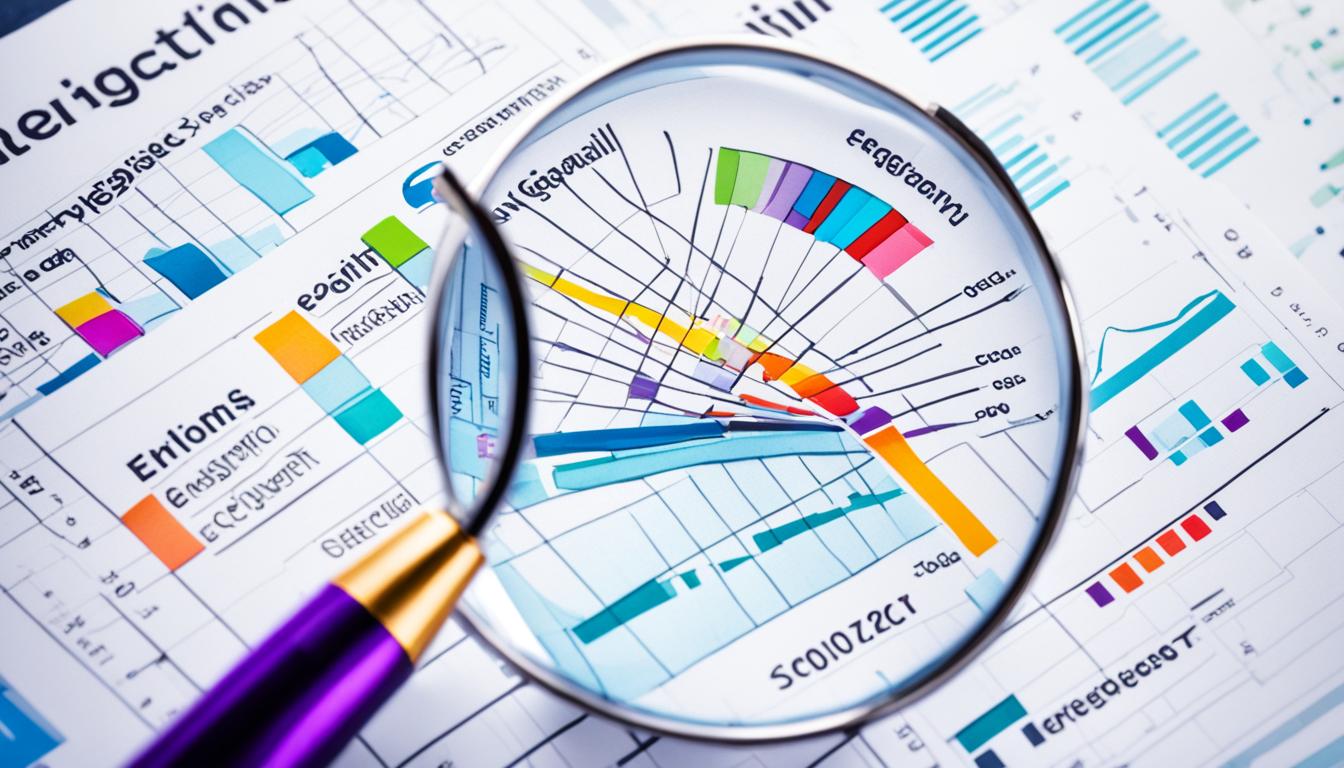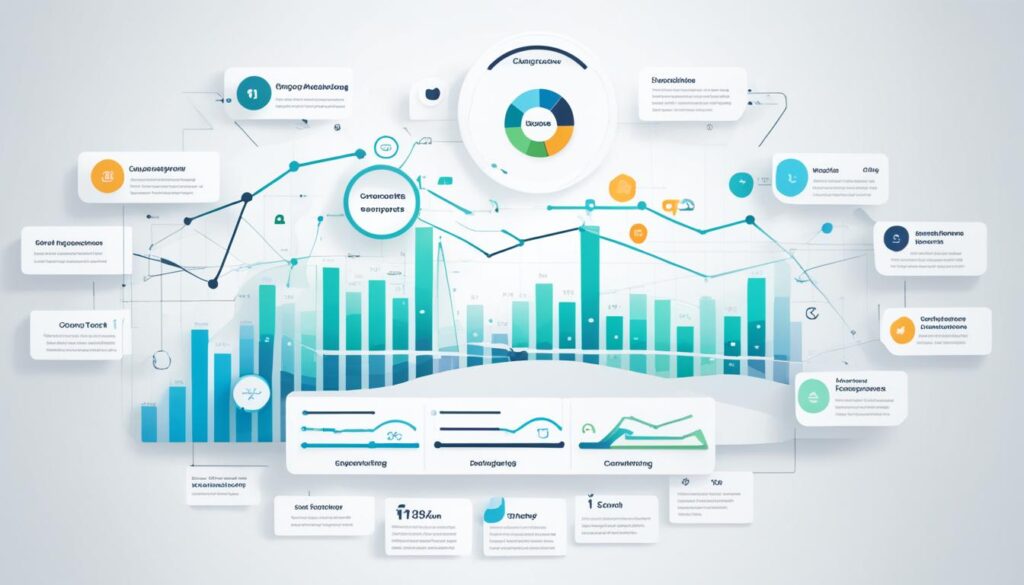
Social media has changed how brands talk to customers, offering real-time interaction. It’s not just about chatting; it’s about the data it produces. From likes and comments to tracking conversions and understanding your audience, this data is key. I’ll show you how to use it to make smart decisions and better marketing results.
We’ll look at the main types of social media analytics, like performance and competitor tracking. I’ll also cover how to pick useful metrics and use the latest tools for better marketing. This will help you understand your audience, beat the competition, and see real results.
If you’re new to social media data analysis or a pro, this article is for you. Get ready to learn how to understand your audience, outdo your rivals, and see clear results. Let’s dive in!
Understanding the Importance of Social Media Analytics
Social media analytics are key for marketers today. They help us understand what works and what doesn’t in our marketing. This data lets us make better choices for our campaigns.
One big plus of social media analytics is trendspotting. We can see what’s hot and what’s not by looking at how people interact with our content. This helps us make sure our content is what our audience wants.
Brand sentiment analysis is another big deal. It shows us what people think of our brand online. We can quickly fix any issues and keep our brand looking good.
Social media analytics also help us see how valuable our content is. By tracking how many people see and interact with it, we can figure out what they think of it. This info helps us set prices and plan our marketing better.
These tools are key for setting goals and showing how our marketing works. By tracking important numbers, we can make sure our social media plans match our business goals. This shows the value of what we spend on marketing.
In short, social media analytics are a must for marketers who want to succeed. They give us the insights we need to make smart choices. With these insights, we can improve our campaigns, boost our brand, and hit our marketing targets.
Key Types of Social Media Analytics to Track
Social media marketing relies heavily on data. By tracking the right analytics, businesses can learn a lot. This helps them improve their marketing and reach their audience better. Let’s look at the main types of social media analytics to keep an eye on:
Performance Analysis: This looks at metrics like impressions, reach, and engagement (likes, comments, shares). These numbers show how well your content is doing and how your audience feels about it.
Audience Analytics: Knowing who your audience is, like their age, location, and interests, helps you make content they’ll love.
Competitor Analysis: Seeing how your competitors do in terms of followers, engagement, and content performance lets you check your own strategy. It also shows where you can get better.
Paid Social Analytics: For brands with social media ads, tracking ad performance and ROI helps you spend your money wisely. This ensures you’re getting the best out of your ads.
Influencer Analysis: Keeping an eye on how your influencer partnerships work, like engagement and reach, helps you pick the best influencers. This sharpens your influencer marketing strategy.
Sentiment Analysis: Looking at what people say about your brand on social media gives you insights into how customers feel. It helps you tackle any negative feedback or crises early.
By focusing on these key analytics, businesses can understand their social media performance, audience, and competition. This knowledge guides their marketing strategy and leads to better results.
| Social Media Analytics Type | Key Metrics |
|---|---|
| Performance Analysis | Impressions, Reach, Engagement (Likes, Comments, Shares) |
| Audience Analytics | Demographics (Age, Location, Interests) |
| Competitor Analysis | Follower Count, Engagement Rates, Content Performance |
| Paid Social Analytics | Ad Performance, ROI |
| Influencer Analysis | Engagement, Reach, Conversions |
| Sentiment Analysis | Brand Perception, Customer Emotions |
Competitor Analysis: Benchmarking Against Industry Peers
As a savvy social media marketer, I know how important it is to analyze competitors. By comparing my brand to others in the industry, I learn a lot. This helps me improve my marketing and beat the competition.
Doing a deep dive into competitors means looking at their followers, how engaged they are, what kind of content they share, and their ads. This helps me set goals and find ways to make my brand stand out.
| Metric | Competitor A | Competitor B | Competitor C | My Brand |
|---|---|---|---|---|
| Followers | 50,000 | 75,000 | 40,000 | 35,000 |
| Engagement Rate | 3.2% | 2.8% | 4.1% | 2.9% |
| Video Content (%) | 45% | 30% | 35% | 25% |
| Paid Ad Spend | $20,000/month | $15,000/month | $12,000/month | $8,000/month |
Looking at this data gives me competitive insights to boost my social media. For instance, I might plan to share more videos or spend more on ads. This could help me get more people engaged and grow my followers.

Competitor analysis is key to my social media strategy. It helps me make smart choices and stay on top in the fast-changing digital world.
Paid Social Analytics: Tracking Ad Performance and Optimizing Spend
As a digital marketer, I understand the need to watch key metrics closely. Metrics like clicks, click-through rate, and cost-per-click help me see how well my paid social analytics are doing. By looking at this data, I can figure out if my ad performance tracking is paying off. This helps me make smart choices to improve my ads and advertising ROI.
Others also read this article : Social Media for Affiliate Marketing Success
Combining my paid social analytics with my social media data gives me a full picture of my campaigns’ success. This lets me spot top-performing campaigns and tweak my bidding strategies for better campaign optimization. I can also focus on the content that my audience likes the most. By always checking and tweaking my plans based on the data, I make sure my ads are doing their job well.

Using advertising analytics has changed the game for my business. By making choices based on data, I’ve gotten better at targeting my audience, boosting engagement and conversions, and improving my marketing ROI. The insights from paid social analytics are key to my strategy. They help me fine-tune my campaigns for the best results.
Influencer Analysis: Measuring the Impact of Influencer Campaigns
In the digital marketing world, influencer partnerships are key for brands to connect with their audience. To really see how well these partnerships work, it’s vital to look at the data. Analyzing your influencer campaigns is crucial.
One important thing to watch is the number of posts created by each influencer. This shows how often your brand is being shared. Also, keep an eye on the total engagements per post. This tells you how much your audience is interacting with the content, which is key for the influencer marketing ROI.
It’s also important to look at the size of each influencer’s audience. A big audience doesn’t always mean more engagement, but it shows how wide your campaign can reach. Knowing who these people are and what they like helps you pick the right influencers for your goals.
Lastly, check how often branded hashtags are used. This shows how visible and well-known your brand is because of your influencers. This info can help shape your future influencer campaign metrics and your overall strategy.
By carefully looking at these metrics, you can learn a lot about your influencer partnerships. This helps you make smart choices to boost audience engagement and get the most from your investment.

Social Media Data Analysis: How to Interpret the Data to Improve Marketing Results
As a marketing pro, understanding social media analytics is key. It helps you make better strategies and get better results. By looking at trends and knowing what your audience likes, you can improve your content and marketing.
Analyzing social media data opens up new ways to make customers happier, spend less on marketing, and get stronger results. You can track things like follower numbers, likes, and shares. You can also see how people feel about your brand and compare yourself to others in your industry.
Knowing what your audience likes is crucial. By looking at the data, you can learn about their interests and what content they like. With this info, you can make your social media better match what your audience wants.
| Key Social Media Analytics Metrics | Importance for Marketing |
|---|---|
| Follower count | Measure brand awareness and audience growth |
| Likes and shares | Gauge content engagement and shareability |
| Reach and impressions | Evaluate the visibility and potential impact of your content |
| Social sentiment | Monitor brand perception and identify potential crises |
| Competitive benchmarking | Understand your industry position and identify areas for improvement |
Using social media data analysis can change your marketing for the better. It helps you make your content and targeting better. Data insights are your best tool in the fast-changing world of social media.
Sentiment Analysis: Gauging Brand Perception and Customer Emotions
Understanding how your audience feels about your brand is key to success. Sentiment analysis is a powerful tool that uncovers insights into customer emotions and satisfaction. It helps you see how people feel about your brand.
This method uses machine learning to analyze text, like social media posts and reviews. It shows what customers think about your products and services. By watching these conversations, businesses learn what their customers like and dislike.
The Net Sentiment Score is a key metric in sentiment analysis. It tells you if people feel positive, negative, or neutral about your brand. This info helps marketers improve their strategies and make customers happier.
Keeping an eye on sentiment over time is very useful. It lets marketers see how feelings change and adjust their plans. This way, they can fix problems and make the most of what people like about their brand.
Tools like Mention, Talkwalker, and Brandwatch help marketers understand social media feelings. They can see trends, check how campaigns work, and talk to their audience better. Knowing what customers say in reviews and surveys helps businesses make better choices and improve the customer experience.
Sentiment analysis is not just for checking brand reputation. It’s also key in market research. By looking at what consumers say, marketers can learn more about their audience. This helps them make marketing plans that work better.
But, sentiment analysis has its challenges. Things like sarcasm and cultural references can be tricky. Marketers need to be careful and understand the cultural background of the sentiment.
By using sentiment analysis, marketers can really get to know their customers. This helps them build a strong brand and grow their business. It’s a powerful tool that makes data-driven decisions and improves the customer experience.
Others also read this article : Instagram Profit Affiliate Marketing: Boost Your Income
| Metric | Description | Implication |
|---|---|---|
| Positive Sentiment | Expressions of approval, satisfaction, joy, or excitement | Reinforces brand loyalty and attracts new customers |
| Negative Sentiment | Expressions of dissatisfaction, complaints, criticism, disappointment, sadness, or anger | Signals areas for improvement and potential risks |
| Neutral Sentiment | Lack of strong positive or negative emotions, including factual remarks or inquiries | May indicate a need for further engagement or clarification |
Best Social Media Analytics Tools and Platforms
When it comes to social media data analysis, having the right tools and platforms is key. There are many social media analytics solutions out there, each with its own strengths. It’s important to find platforms that can bring together data from different social channels and other customer data sources.
Hootsuite is a top choice, winning a 2024 TrustRadius Most Loved Award. It connects with tools like Adobe Experience Manager CMS for a full view of social media analytics. You get custom reporting, industry benchmarks, and tips on the best times to post based on past data.
Sprout Social is a top social media analytics tools provider. It tracks performance on platforms like Facebook, Instagram, LinkedIn, and more. Sendible has 200 analytics modules for deep analysis across networks, while Keyhole is great for real-time monitoring for agencies, brands, and media industries.
For influencer-focused analytics, IZEA is a top pick. It gives you metrics on reach, engagement, and audience details. BuzzSumo and Rival IQ are also great, helping you track content performance and see how you stack up against competitors.
The best social media analytics platforms offer easy cross-channel data integration, clear data visualization, and actionable insights. With the right unified analytics platforms, you can see the full picture of your marketing efforts. This helps you make smarter decisions.
Implementing Social Media Analytics in Your Strategy
Adding social media analytics to your marketing plan is key for making smart decisions and always improving. By using the data from your social channels, you can learn a lot to make your marketing better.
First, figure out what matters most to measure your social media success. Important metrics include likes, views, new followers, clicks, and sales. Checking these often helps you spot trends, know what your audience likes, and improve your posts and campaigns.
Use a good social media analytics tool to collect and look at data from platforms like Facebook, Twitter, Instagram, LinkedIn, and others. These tools give you detailed info on who your audience is, how well your content does, and how your campaigns are doing. By looking at and understanding this data, you can make smart choices to improve your data-driven marketing strategy and hit your goals.
Always keep making your strategy better. Integrating social media analytics helps you check and tweak your approach often. This way, you make sure you’re sharing content that really speaks to your audience. By using data to guide you, you can fully use social media to grow your business in a lasting way.
Conclusion
Learning how to analyze social media data is key for marketers. It helps them make their campaigns better and get better results. By looking at important analytics, brands can learn a lot about their audience, how well campaigns do, and what people think of their brand.
Using these insights to shape their content, pick the right audience, and plan their marketing can help businesses focus on their customers. This leads to better marketing goals and results.
It’s important to use a full social media analytics plan to improve marketing and stay ahead. With new platforms like TikTok and Twitch becoming more popular, marketers need to keep up with trends. By using data to guide their choices, businesses can make smarter decisions, create content that grabs attention, and connect better with their audience.
Social media data analysis is more than just checking how campaigns do. It’s a way to really understand your customers and make your marketing better. By focusing on the customer and always improving your approach with data, you can grow your brand for the long term in the changing social media world.





